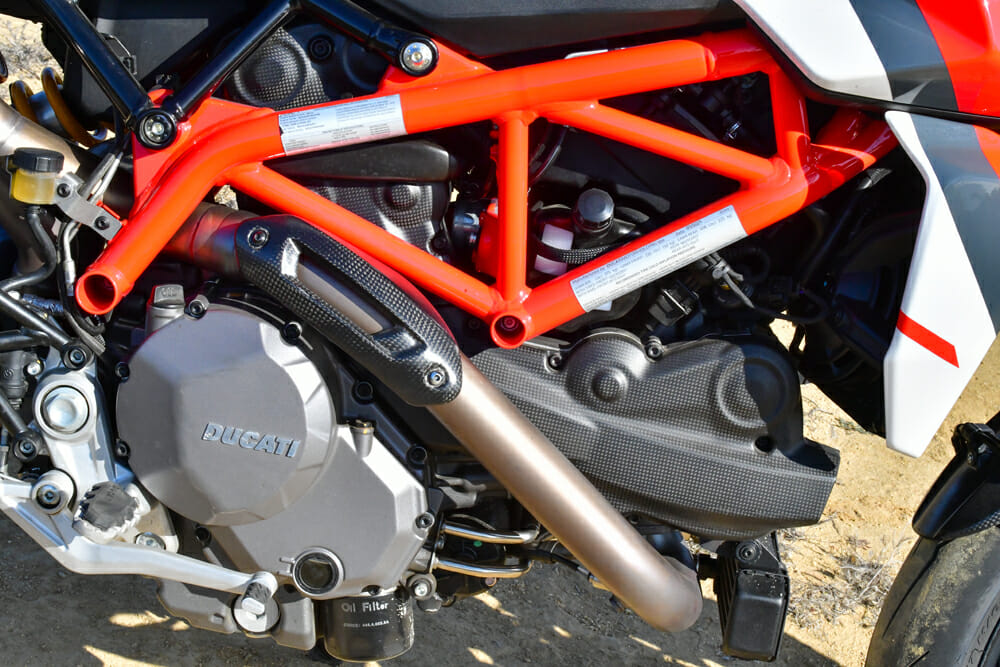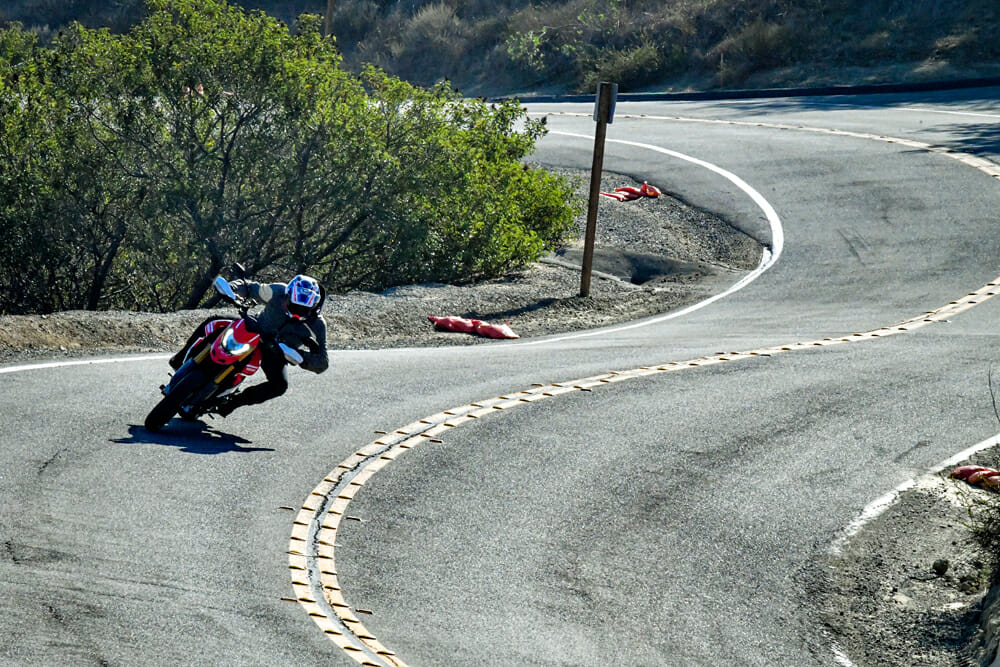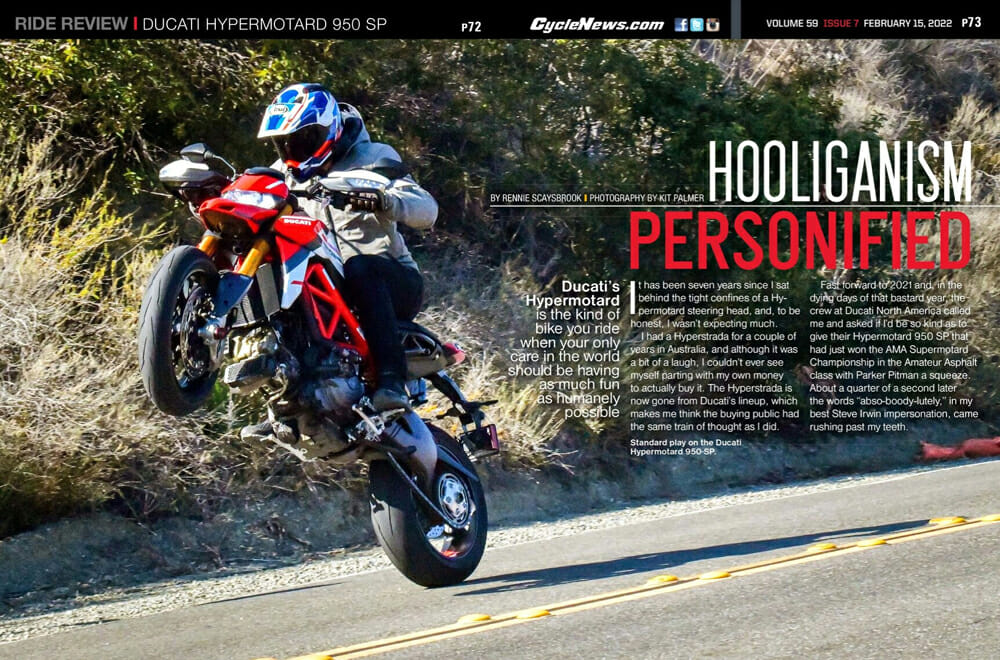Rennie Scaysbrook | February 17, 2022
Ducati’s Hypermotard is the kind of bike you ride when your only care in the world should be having as much fun as humanly possible.
 Standard play on the Ducati Hypermotard 950 SP.
Standard play on the Ducati Hypermotard 950 SP.
By Rennie Scaysbrook | Photography by Kit Palmer
It has been seven years since I sat behind the tight confines of a Hypermotard steering head, and, to be honest, I wasn’t expecting much.
I had a Hyperstrada for a couple of years in Australia, and although it was a bit of a laugh, I couldn’t ever see myself parting with my own money to actually buy it. The Hyperstrada is now gone from Ducati’s lineup, which makes me think the buying public had the same train of thought as I did.
 You can see the dirt bikeness of the seat setup. It’s not comfy for long rides, I can assure you.
You can see the dirt bikeness of the seat setup. It’s not comfy for long rides, I can assure you.
Fast forward to 2021 and, in the dying days of that bastard year, the crew at Ducati North America called me and asked if I’d be so kind as to give their Hypermotard 950 SP that had just won the AMA Supermotard Championship in the Amateur Asphalt class with Parker Pitman a squeeze. About a quarter of a second later the words “abso-boody-lutely,” in my best Steve Irwin impersonation, came rushing past my teeth.
 Parker Pitman was here.
Parker Pitman was here.
On paper, the Hypermotard 950 SP should be my perfect motorcycle. Anyone that knows me knows I love supermoto. One of my two bikes is a 2019 Husqvarna FS 450, but I can’t ride that one the road, so having essentially that bike with twice the capacity—and twice the power—sounds like a recipe for pants-tightening jollies. And it is, but it’s not as simple as that. As you’ll read.
Compared to the Hyper 950, the SP is the one with all the fruit. At $17,495 it’s a healthy $3500 more than the base model 950, but for that cash you get goodies like forged Marchesini aluminum wheels, Öhlins fork and shock, carbon-fiber front guard and timing-belt cover, and the Ducati Quick Shift EVO system for clutchless up-and-down gearshifts (and our test bike also came with the Termignoni muffler as part of the aftermarket accessory catalog).
 There’re very few production motorcycles that’ll keep with a Hypermotard in terms of turn speed.
There’re very few production motorcycles that’ll keep with a Hypermotard in terms of turn speed.
Those extras go with the Bosch IMU, variable riding modes, ABS Bosch Cornering, Ducati Traction Control (DTC) EVO, Ducati Wheelie Control (DWC) EVO, Power Modes, Day Time Running Light (DRL), tapered aluminum handlebars, removable passenger footpegs, and the USB power socket already shared with the base model.
The motor is the same as well, Ducati using their tried-and-true 937cc L-twin Desmo that’s also found in the Monster that debuted earlier last year. The company claims 114 horsepower and 71 lb-ft of torque pushing 440 pounds of ready-to-ride weight with a full 3.8 gallons of gas.
But the story of the Hyper, indeed its personality, is not found in the engine or tech specs. It’s in the chassis, where the dirt bike ethos of a motorcycle aimed squarely at your local canyon come to light.
 Part of the extra $3500 spent gets you a shiny Öhlins fork and this shock, plus the corresponding increase in handling behavior you’d expect from such an upgrade.
Part of the extra $3500 spent gets you a shiny Öhlins fork and this shock, plus the corresponding increase in handling behavior you’d expect from such an upgrade.
With a stupidly tall seat height of 35 inches and a short 4.1 inches of trail, the Hypermotard is unlike any motorcycle with a license plate. The seat on the SP is also different to the base model, it being swiped from the limited-edition Hypermotard RVE and thus the feeling is one of sitting on a flat piece of wood with 114 horsepower in your right hand. You sit right on top of the chassis, perched over the front like a, you guessed it, dirt bike, and thus the Hypermotard will scythe from corner to corner at the mere thought of it. It’s a ride position that’s excellent for tight switchbacks on a mountain road but also brilliant in traffic as you’re sitting bolt upright with plenty of room to see and no weight at all on your wrists.
Conversely, the lack of wind protection of any kind means it’s one of the worst on the highway, as consistent speeds north of 70 mph were not only tiring but had me feeling like I would get blown off the back. It comes with the Hypermotard territory.
 There are 114 Italian horsies hiding in those cases. It’s all you’ll need. Trust me.
There are 114 Italian horsies hiding in those cases. It’s all you’ll need. Trust me.
Thanks to Öhlins, it’s a stiff ride on the SP and certainly not one suitable to long stints in the saddle. Being a quality Öhlins setup, you can fine tune the suspension but at its base the SP is quite stiffly sprung so it’s something to bear in mind if you’re thinking about picking one up. That being said, the chassis composure offered by this setup is bang-on for hard and fast riding, and with the right rider on board it’ll nail a canyon at very close to the same speed as any proper sportbike will—especially when the road starts getting tight.
Compared to my previous Hypermotard experience which was, admittedly, a long time ago, this one was much more enjoyable due to the flexibility of that 937cc motor and the myriad of electronics that come with it. Like any modern Ducati with a sporting glint in its eye, you get basically every electronic bell and whistle, but the way the electronics pamper the rider by making them push that little bit harder without feeling like a dog on a leash is impressive.
 Forged Marzocchi wheels look gorgeous.
Forged Marzocchi wheels look gorgeous.
The variable riding modes and corresponding power modes give you the ability to create your perfect throttle response, and if it all goes wrong you’ve got Bosch’s Cornering ABS to haul you up (within reason).
Around town, the motor is an absolute peach. Low-down throttle response when the ECU is switched to the Road map is delightfully snatch-free, and slow-speed traffic navigating is a joy when tapping on the light-action quickshifter. Start ripping up through the gears on hard acceleration and the Hyper really starts to show its teeth and it can be a proper task to keep the front wheel on the ground if you’ve disengaged the Ducati Wheelie Control system. If it’s active, however, you’ll be faced with plenty of cutting of power as the chassis tries and fails to overtake the electronic bungee cable.
 The perfect road for you and your Hypermotard—lots of sinewy switchbacks, a few short straights, then more switchbacks.
The perfect road for you and your Hypermotard—lots of sinewy switchbacks, a few short straights, then more switchbacks.
This is one of those bikes that doesn’t serve any real purpose other than to put a smile on your face. It’s useless as a long-range touring bike, it’s stiff, mostly uncomfortable, but damn if it’s not one that makes you laugh your butt off each time you ride. I love how unapologetic the Hypermotard 950 SP is. It makes no claims of being anything other than a college-house party on wheels, and I think we all could use a bit of that excitement in our lives these days. CN

2022 Ducati Hypermotard 950 SP Specifications
| MSRP: |
$17,495 |
| Engine: |
11° L-twin, 4-stroke |
| Valvetrain: |
Testastretta 8-valve |
| Displacement: |
937cc |
| Bore x stroke: |
94 x 67.5mm |
| Cooling System: |
Liquid |
| Fueling: |
Ride-by-wire with 53mm throttle bodies |
| Compression ratio: |
13.3:1 |
| Power (claimed): |
114 hp at 9000 rpm |
| Torque (claimed): |
71 lb-ft at 7250 rpm |
| Exhaust: |
2 into 1 |
| Transmission: |
6-speed with Ducati Quick Shift (DQS) up/down EVO 2 |
| Clutch: |
Hydraulically controlled slip and assist |
| Electronics: |
Bosch 6-axis IMU, Ducati Traction Control (DTC) Engine Brake Control EVO (EBC EVO), Cornering ABS EVO, Ducati Wheelie Control EVO (DWC EVO) |
| Chassis: |
Tubular steel trellis |
| Front suspension: |
Fully adjustable 48mm inverted Öhlins fork. 7.3-inches wheel travel |
| Rear suspension: |
Linkage-assisted fully adjustable Öhlins shock. 6.9-inches wheel travel |
| Front brake: |
320mm semi-floating discs with radially-mounted Brembo M4.32 monoblock 4-piston calipers and radial pump. Bosch Cornering ABS EVO |
| Rear brake: |
245mm disc, twin-piston caliper with Bosch Cornering ABS EVO |
| Front tire: |
Pirelli Diablo Supercorsa SP 120/70 ZR17 |
| Rear tire: |
Pirelli Diablo Supercorsa SP 180/55 ZR17 |
| Rake: |
25° |
| Wheelbase: |
58.8 in. |
| Seat height: |
35 in. |
| Fuel capacity: |
3.8 gal. |
| Weight (curb, claimed): |
440 lbs. |
